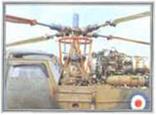• Anti-tank • Casualty evacuation • Battlefield liaison

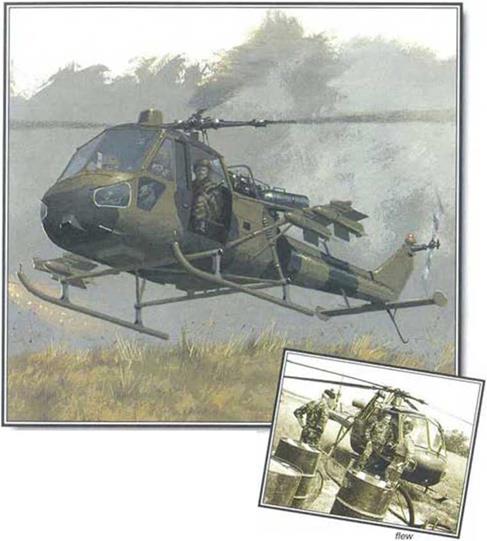
Westland’s Scout was a versatile and reliable helicopter which was retired from the British Army in 1994. Serving in the anti-armour and scout helicopter role, it was similar to the naval Wasp. Despite boing a rather limited machine built using old technology, the Scout was very popular. During the Falklands War, Scouts rescued injured soldiers while under fire, and fired wire – guided missiles at enemy strongpoints.
▼ Wet feet
During the Falklands War a Scout suffered a main gearbox failure while hovenng over a lake to avoid Argentine fighters. The pilot had to ditch the helicopter.
A Rocket launcher
A Scout gunner was required to stoer the SS. 11 missile to its target through thin command wires. The SS. 11 was a powerful weapon, but the wires often snagged and broke in flight.


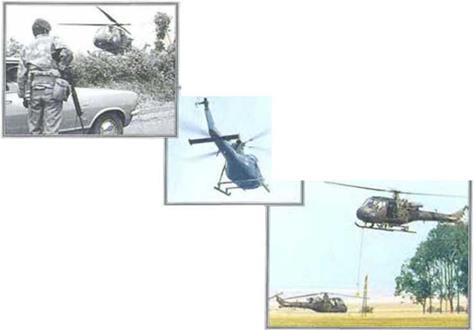 ▼ Bucket balancing
▼ Bucket balancing
It was a test of skill to fly tho Scout well, but the Army Air Corps finest pilots could carry a bucket through a scries of posts as part of the Bntish Helicopter Championships.
FACTS AND FIGURES
► A Scout pilot won tho Distinguished Flying Cross In tho Falklands for flying under fire to rescue a severely injured soldier.
► Total production of the Westland Scout numbered 150 aircraft.
► King Hussein of Jordan had a Scout for his own personal use.
► The Empire Test Pilot School at Boscombo Down flew a Scout in their ■raspberry ripple’ colour scheme.
► Two Scouts wore operated from survey ships by the Royal Australian Navy.
► A Scout still flies with the British Army’s historic flight at Middlo Wallop.
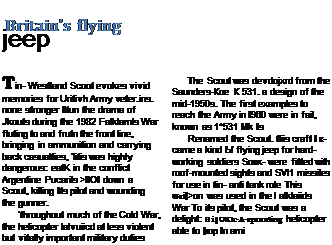 |
|
|
|
Below: Formations of Scouts over the Bntish Army’s training area on Salisbury Plain were a common sight when the craft was based at the camp af Middle Wallop.
|
|
|
Type: i-ve-seal light utility helicopter
Powerplanl: one sn-xw (685-hp.) Ro is-Royco (Bristol Srddoloy) Nimbus MX 101 or Mk 102 tree-turbine turboshaft engine
Maximum speed: 212 kmth (t3t mp. h i
Rate of climb: 15S m/ггіл (506І. рлд
Range: SlOkmpiemi)
Service ceiling: 4085 m (13.400 fi i
Weights: empty 1466 kg (3.2231Ы. loaded 2-Ю5 kg (5.291 lb 1
Armament: various option» including manually amed guns of up to 20-mm calibre fixed 7.62-mm mactvne-gon installations, rocket pods or four SS. t 1 masrles
|
|
|
Above: Tho Scout and SS. 11 was one of the first helicopter – missito combinations, and was reasonably successful.
out of tight places. Scouts were very Inisy in Northern Ireland, used as a high-flying surveillance platform over the ІКИХІСІ and for moMiig troops to clieckpoinLs
|
|
|
Dimensions:
mam rotor diameter length (rotors turning) height (rotors turning) rotor disc area
|
|
|
9 S3 m (32 ft 3 in, I 12.2 m (40 ft.) 3.56 m (11 tl. am.) 75 89 m – (817 sq ft.)
|
|
|
|
 |
|
Tho man rotor fod few bbdee of at motol construction Thofufy ailiculated Kit» find lljfxxrig and draggxig tinges
|
|
|
The taa rotor was a smpte. tv/o-btodod met* type with a central flapping hrngo
|
|
|
The cockpit of the Scout was very spartan An autcpiSot/’autostabiiser system could be titled.
|
|
|
For UN operations, the Scout traded m its гиіюпаї markings for toe tamous t*« msqrua
|
|
|
|
 |
|
Urrtke ts nova counterpart, the Wasp die Scout had a email hocuontol Btotmser under toe пли of Uw talboom.
|
|
|
Tho fuMtago struciuro was a» met* semi monocooun. The tail rotor driveshaft ran аюпд toe lop ot toe tadboom.
|
|
|
the pA3l «о! m the right золі, with tho
obnonwrmittBu петит n trio left swat.
|
|
|
ІЙМ І1И-.»Л.| шміі ішя. аом IK kBik (117 m. p.h.) ‘-~
|
|
|
|
|
|
|
|
|
HEAT WARHEAD: The
cavity of too explosive. i mrvtal P-icr of die warwj super-heated gas. досі
|
|
|
MANUAL GUIDANCE: Keeping the nvssile on track was tho gunner’s rote Ho looked Й trough tho silo, keeping tho tergot in the centre ol the crosshairs and mokrg any ndrasi merits to tho course with u am ей joystick.
|
|
|
|
 |
|
MISSILE LAUNCH: The
SS.11 had a
maximum rango of f.
/usl 3 km (1.8 mi.), * "Д
so the Scout usually fired from a concealed position
|
|
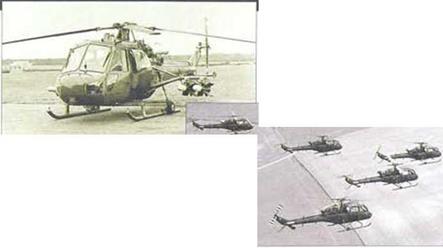


Westland




 ▼ Bucket balancing
▼ Bucket balancing